Xác định tập nghiệm $S$ của bất phương trình $\ln{x^2} > \ln\left( {4x - 4} \right)$
Điều kiện $x>1$
$\ln{x^2} > \ln\left( {4x - 4} \right)$
\( \Leftrightarrow {x^2} > 4x - 4\, \Leftrightarrow {(x - 2)^2} > 0 \Leftrightarrow x \ne 2\)
\(S = \left( {1; + \infty } \right)\backslash \left\{ 2 \right\}\)
Tập nghiệm của bất phương trình $2017{\log _2}x \le {4^{{{\log }_2}9}}$ là
$2017{\log _2}x \le {9^{{{\log }_2}4}} = 81$
$ \Leftrightarrow {\log _2}x = \dfrac{{81}}{{2017}} = > 0 < x \le \sqrt[{2017}]{{{2^{81}}}}$
Tập nghiệm của bất phương trình ${\left( {\sqrt 5 - 2} \right)^{\dfrac{{2x}}{{x - 1}}}} \le {\left( {\sqrt 5 + 2} \right)^x}$ là:
${\left( {\sqrt 5 - 2} \right)^{\dfrac{{2x}}{{x - 1}}}} \le {\left( {\sqrt 5 + 2} \right)^x}$$ \Leftrightarrow {\left( {\sqrt 5 + 2} \right)^{\dfrac{{ - 2x}}{{x - 1}}}} \le {\left( {\sqrt 5 + 2} \right)^x}$$ \Leftrightarrow - \dfrac{{2x}}{{x - 1}} \le x$
$ \Leftrightarrow \dfrac{{2x}}{{x - 1}} + x \ge 0$$ \Leftrightarrow \dfrac{{{x^2} + x}}{{x - 1}} \ge 0 \Leftrightarrow - 1 \le x \le 0 \vee x > 1$ .
Tập nghiệm của phương trình \({\log _3}\left( {{{\log }_{\frac{1}{2}}}x} \right) < 1\) là
Điều kiện: $x>0$; ${\log _{\frac{1}{2}}}x > 0 \Rightarrow x < {\left( {\dfrac{1}{2}} \right)^0} = 1$
\({\log _3}\left( {{{\log }_{\frac{1}{2}}}x} \right) < 1 = {\log _3}3 \Leftrightarrow {\log _{\frac{1}{2}}}x < 3 = {\log _{\frac{1}{2}}}{\left( {\dfrac{1}{2}} \right)^3}\)
\( \Leftrightarrow x > {\left( {\dfrac{1}{2}} \right)^3} = \dfrac{1}{8}\) vì \(\dfrac{1}{2} < 1\)
Giải bất phương trình: $\log _2^2x - 4033{\log _2}x + 4066272 \le 0$ .
Điều kiện: $x>0$
Đặt $t = {\log _2}x$
BPT $ \Leftrightarrow {t^2} - 4033t + 4066272 \le 0$
$ \Leftrightarrow 2016 \le t \le 2017$
=>$2016 \le {\log _2}x \le 2017$
$ \Leftrightarrow {2^{2016}} \le x \le {2^{2017}}$
Tìm tập nghiệm $S$ của bất phương trình ${\log _{\frac{1}{2}}}\left( {x + 2} \right) - {\log _{\frac{1}{{\sqrt 2 }}}}(x) > {\log _2}({x^2} - x) - 1$
Thử giá trị $x = 3:{\log _{\frac{1}{2}}}\left( {x + 2} \right) - {\log _{\frac{1}{{\sqrt 2 }}}}\left( x \right) - {\log _2}\left( {{x^2} - x} \right) + 1 < 0$: Loại đáp án A
Thử giá trị $x = 2:{\log _{\frac{1}{2}}}\left( {x + 2} \right) - {\log _{\frac{1}{{\sqrt 2 }}}}\left( x \right) - {\log _2}\left( {{x^2} - x} \right) + 1 = 0$: Loại đáp án D
Thử giá trị $x = 0,5$: MATH ERROR: Loại đáp án C
Tập nghiệm của bất phương trình ${\log _3}x \le {\log _{\frac{1}{3}}}(2x)$ là nửa khoảng $(a;b{\rm{]}}$. Giá trị của ${a^2} + {b^2}$ bằng
Điều kiện: \(x > 0\).
${\log _3}x \le {\log _{\frac{1}{3}}}(2x) \Leftrightarrow {\log _3}x \le - {\log _3}(2x)$
$ \Leftrightarrow {\log _3}x + {\log _3}(2x) \le 0$
$ \Leftrightarrow {\log _3}(2{x^2}) \le 0$
$ \Leftrightarrow 2{x^2} \le 1$
$ \Leftrightarrow - \dfrac{{\sqrt 2 }}{2} \le x \le \dfrac{{\sqrt 2 }}{2}$.
Kết hợp với \(x > 0\) ta được \(0 < x \le \dfrac{{\sqrt 2 }}{2}\).
Do đó $\left\{ \begin{array}{l}a = 0\\b = \dfrac{{\sqrt 2 }}{2}\end{array} \right. \Rightarrow {a^2} + {b^2} = \dfrac{1}{2}$
Tập nghiệm của bất phương trình \({9^{\log _9^2x}} + {x^{{{\log }_9}x}} \le 18\) là:
ĐKXĐ: \(x > 0\).
Ta có:
\(\begin{array}{l}{9^{\log _9^2x}} + {x^{{{\log }_9}x}} \le 18\\ \Leftrightarrow {9^{{{\log }_9}x.{{\log }_9}x}} + {x^{{{\log }_9}x}} \le 18\\ \Leftrightarrow {\left( {{9^{{{\log }_9}x}}} \right)^{{{\log }_9}x}} + {x^{{{\log }_9}x}} \le 18\\ \Leftrightarrow {x^{{{\log }_9}x}} + {x^{{{\log }_9}x}} \le 18\\ \Leftrightarrow 2.{x^{{{\log }_9}x}} \le 18\\ \Leftrightarrow {x^{{{\log }_9}x}} \le 9\end{array}\)
Lấy logarit cơ số 9 cả 2 vế bất phương trình ta được:
\(\begin{array}{l}{\log _9}\left( {{x^{{{\log }_9}x}}} \right) \le {\log _9}9\\ \Leftrightarrow {\log _9}x.{\log _9}x \le 1\\ \Leftrightarrow \log _9^2x \le 1\\ \Leftrightarrow - 1 \le {\log _9}x \le 1\\ \Leftrightarrow \dfrac{1}{9} \le x \le 9\end{array}\)
Kết hợp điều kiện xác định ta có \(x \in \left[ {\dfrac{1}{9};9} \right]\).
Vậy tập nghiệm của bất phương trình là: \(S = \left[ {\dfrac{1}{9};9} \right]\).
Tập nghiệm của bất phương trình\({\log _2}\left( {x\sqrt {{x^2} + 2} + 4 - {x^2}} \right) + 2x + \sqrt {{x^2} + 2} \le 1\) là \(\left( { - \sqrt a ; - \sqrt b } \right]\). Khi đó \(ab\) bằng
Điều kiện : \(x\sqrt {{x^2} + 2} + 4 - {x^2} > 0 \Leftrightarrow x\left( {\sqrt {{x^2} + 2} - x} \right) + 4 > 0 \Leftrightarrow x.\dfrac{2}{{\sqrt {{x^2} + 2} + x}} + 4 > 0\)
\( \Leftrightarrow \dfrac{{2x}}{{\sqrt {{x^2} + 2} + x}} + \dfrac{{4\left( {\sqrt {{x^2} + 2} + x} \right)}}{{\sqrt {{x^2} + 2} + x}} > 0 \Rightarrow 6x + 4\sqrt {{x^2} + 2} > 0\) (vì \(\sqrt {{x^2} + 2} > x;\,\forall x\) )
\( \Leftrightarrow 2\sqrt {{x^2} + 2} > - 3x \Leftrightarrow \left[ \begin{array}{l} - 3x < 0\\\left\{ \begin{array}{l} - 3x \ge 0\\4\left( {{x^2} + 2} \right) > {\left( { - 3x} \right)^2}\end{array} \right.\end{array} \right. \Leftrightarrow \left[ \begin{array}{l}x > 0\\\left\{ \begin{array}{l}x \le 0\\5{x^2} < 8\end{array} \right.\end{array} \right. \Leftrightarrow \left[ \begin{array}{l}x > 0\\ - \dfrac{{\sqrt {40} }}{5} < x \le 0\end{array} \right.\)
Khi đó ta có \({\log _2}\left( {x\sqrt {{x^2} + 2} + 4 - {x^2}} \right) + 2x + \sqrt {{x^2} + 2} \le 1\)
\(\begin{array}{l} \Leftrightarrow {\log _2}\left( {x\left( {\sqrt {{x^2} + 2} - x} \right) + 4} \right) + 2x + \sqrt {{x^2} + 2} \le 1\\ \Leftrightarrow {\log _2}\left( {\dfrac{{2x}}{{\sqrt {{x^2} + 2} + x}} + 4} \right) + 2x + \sqrt {{x^2} + 2} \le 1\\ \Leftrightarrow {\log _2}\left( {\dfrac{{6x + 4\sqrt {{x^2} + 2} }}{{\sqrt {{x^2} + 2} + x}}} \right) + 2x + \sqrt {{x^2} + 2} \le 1\end{array}\)
\(\begin{array}{l} \Leftrightarrow {\log _2}\left( {6x + 4\sqrt {{x^2} + 2} } \right) - {\log _2}\left( {\sqrt {{x^2} + 2} + x} \right) + 2x + \sqrt {{x^2} + 2} \le 1\\ \Leftrightarrow {\log _2}\left[ {2\left( {3x + 2\sqrt {{x^2} + 2} } \right)} \right] - {\log _2}\left( {\sqrt {{x^2} + 2} + x} \right) + 2x + \sqrt {{x^2} + 2} \le 1\\ \Leftrightarrow {\log _2}2 + {\log _2}\left( {3x + 2\sqrt {{x^2} + 2} } \right) - {\log _2}\left( {\sqrt {{x^2} + 2} + x} \right) + 2x + \sqrt {{x^2} + 2} \le 1\\ \Leftrightarrow 1 + {\log _2}\left( {3x + 2\sqrt {{x^2} + 2} } \right) - {\log _2}\left( {\sqrt {{x^2} + 2} + x} \right) + 2x + \sqrt {{x^2} + 2} \le 1\\ \Leftrightarrow {\log _2}\left( {3x + 2\sqrt {{x^2} + 2} } \right) + 3x + 2\sqrt {{x^2} + 2} \le {\log _2}\left( {\sqrt {{x^2} + 2} + x} \right) + x + \sqrt {{x^2} + 2} \,\left( * \right)\end{array}\)
Xét hàm số \(f\left( t \right) = t + {\log _2}t\,\) với \(t > 0\) ta có \(f'\left( t \right) = 1 + \dfrac{1}{{t.\ln 2}} > 0;\,\forall t > 0\) nên \(f\left( t \right)\) là hàm đồng biến trên \(\left( {0; + \infty } \right)\)
Từ đó
\(\begin{array}{l}\left( * \right) \Leftrightarrow f\left( {3x + 2\sqrt {{x^2} + 2} } \right) \le f\left( {\sqrt {{x^2} + 2} + x} \right)\\ \Leftrightarrow 3x + 2\sqrt {{x^2} + 2} \le \sqrt {{x^2} + 2} + x\\ \Leftrightarrow \sqrt {{x^2} + 2} \le - 2x\\ \Leftrightarrow \left\{ \begin{array}{l} - 2x \ge 0\\{x^2} + 2 \le 4{x^2}\end{array} \right. \Leftrightarrow \left\{ \begin{array}{l}x \le 0\\3{x^2} \ge 2\end{array} \right. \Leftrightarrow \left\{ \begin{array}{l}x \le 0\\\left[ \begin{array}{l}x \ge \dfrac{{\sqrt 6 }}{3}\\x \le - \dfrac{{\sqrt 6 }}{3}\end{array} \right.\end{array} \right. \Leftrightarrow x \le - \dfrac{{\sqrt 6 }}{3}\end{array}\)
Kết hợp điều kiện \(\left[ \begin{array}{l}x > 0\\ - \dfrac{{\sqrt {40} }}{5} < x \le 0\end{array} \right.\) ta có \( - \dfrac{{\sqrt {40} }}{5} < x \le - \dfrac{{\sqrt 6 }}{3}\) hay \( - \sqrt {\dfrac{8}{5}} < x \le - \sqrt {\dfrac{2}{3}} \)
Tập nghiệm bất phương trình \(S = \left( { - \sqrt {\dfrac{8}{5}} ; - \sqrt {\dfrac{2}{3}} } \right]\) nên \(a = \dfrac{8}{5};b = \dfrac{2}{3} \Rightarrow a.b = \dfrac{8}{5}.\dfrac{2}{3} = \dfrac{{16}}{{15}}.\)
Cho hàm số \(f\left( x \right)\) liên tục trên \(\mathbb{R}\) và có đồ thị \(f'\left( x \right)\) như hình vẽ bên. Bất phương trình \({\log _5}\left[ {f\left( x \right) + m + 2} \right] + f\left( x \right) > 4 - m\) đúng với mọi \(x \in \left( { - 1;4} \right)\) khi và chỉ khi
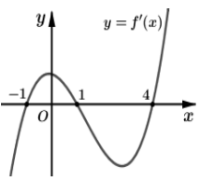
ĐK : \(f\left( x \right) + m + 2 > 0\)
Ta có \({\log _5}\left( {f\left( x \right) + m + 2} \right) + f\left( x \right) > 4 - m\) \( \Leftrightarrow {\log _5}\left( {f\left( x \right) + m + 2} \right) + f\left( x \right) + m + 2 > 6\) (*)
Xét hàm số \(y = {\log _5}t + t\,\,\,\left( {t > 0} \right)\) có \(y' = \dfrac{1}{{t.\ln 5}} + 1 > 0\) với \(t > 0\)
Nên hàm số \(y = {\log _5}t + t\) đồng biến trên \(\left( {0; + \infty } \right)\), lại có \(y\left( 5 \right) = {\log _5}5 + 5 = 6\)
Nên từ (*) suy ra \(y\left( {f\left( x \right) + m + 2} \right) > y\left( 5 \right) \Leftrightarrow f\left( x \right) + m + 2 > 5 \Leftrightarrow f\left( x \right) > 3 - m\) (1)
Từ hình vẽ ta có BBT của hàm số \(f\left( x \right)\) như sau

Từ hình vẽ ta có \(\int\limits_{ - 1}^1 {\left| {f'\left( x \right)} \right|} dx < \int\limits_1^4 {\left| {f'\left( x \right)} \right|dx} \Leftrightarrow \int\limits_{ - 1}^1 {f'\left( x \right)} dx < - \int\limits_1^4 {f'\left( x \right)dx} \)
\( \Leftrightarrow \left. {f\left( x \right)} \right|_{ - 1}^1 < \left. { - f\left( x \right)} \right|_1^4 \Leftrightarrow f\left( 1 \right) - f\left( { - 1} \right) < f\left( 1 \right) - f\left( 4 \right)\) \( \Leftrightarrow f\left( { - 1} \right) > f\left( 4 \right)\) (2)
Từ (1) ; (2) và BBT ta thấy để phương trình đã cho đúng với \(x \in \left( { - 1;4} \right)\) suy ra \(3 - m \le f\left( 4 \right) \Leftrightarrow m \ge 3 - f\left( 4 \right).\)
Cho phương trình \({\log _7}\left( {{x^2} + 2x + 2} \right) + 1 > {\log _7}\left( {{x^2} + 6x + 5 + m} \right)\). Có tất cả bao nhiêu giá trị nguyên của tham số m để bất phương trình trên có tập nghiệm chứa khoảng \(\left( {1;3} \right)\)?
ĐK: \({x^2} + 6x + 5 + m > 0.\)
\(\begin{array}{l}{\log _7}\left( {{x^2} + 2x + 2} \right) + 1 > {\log _7}\left( {{x^2} + 6x + 5 + m} \right)\\ \Leftrightarrow {\log _7}7\left( {{x^2} + 2x + 2} \right) > {\log _7}\left( {{x^2} + 6x + 5 + m} \right)\\ \Leftrightarrow 7\left( {{x^2} + 2x + 2} \right) > {x^2} + 6x + 5 + m\\ \Leftrightarrow 7{x^2} + 14x + 14 - {x^2} - 6x - 5 - m > 0\\ \Leftrightarrow 6{x^2} + 8x + 9 - m > 0\end{array}\)
Bất phương trình đã cho có tập nghiệm chứa \(\left( {1;3} \right)\)
\(\begin{array}{l} \Leftrightarrow \left\{ \begin{array}{l}{x^2} + 6x + 5 + m > 0,\forall x \in \left( {1;3} \right)\\6{x^2} + 8x + 9 - m > 0,\forall x \in \left( {1;3} \right)\end{array} \right.\\ \Leftrightarrow \left\{ \begin{array}{l}m > - {x^2} - 6x - 5,\forall x \in \left( {1;3} \right)\\m < 6{x^2} + 8x + 9,\forall x \in \left( {1;3} \right)\end{array} \right.\,\,\left( * \right)\end{array}\)
\( \Leftrightarrow \left\{ \begin{array}{l}m \ge \mathop {\max }\limits_{\left[ {1;3} \right]} f\left( x \right)\\m \le \mathop {\min }\limits_{\left[ {1;3} \right]} g\left( x \right)\end{array} \right.\)
với \(f\left( x \right) = - {x^2} - 6x - 5\) và \(g\left( x \right) = 6{x^2} + 8x + 9\)
Ta có:
\(f'\left( x \right) = - 2x - 6 = 0\) \( \Leftrightarrow x = - 3 \notin \left( {1;3} \right)\) và \(f'\left( x \right) < 0,\forall x \in \left( {1;3} \right)\) nên hàm số \(y = f\left( x \right)\) nghịch biến trên \(\left( {1;3} \right)\)
\( \Rightarrow \mathop {\max }\limits_{\left[ {1;3} \right]} f\left( x \right) = f\left( 1 \right) = - 12\) \( \Rightarrow m \ge - 12\)
\(g'\left( x \right) = 12x + 8 = 0\) \( \Leftrightarrow x = - \frac{2}{3} \notin \left( {1;3} \right)\) và \(g'\left( x \right) > 0,\forall x \in \left( {1;3} \right)\) nên hàm số \(y = g\left( x \right)\) đồng biến trên \(\left( {1;3} \right)\)
\( \Rightarrow \mathop {\min }\limits_{\left[ {1;3} \right]} g\left( x \right) = g\left( 1 \right) = 23\) \( \Rightarrow m \le 23\)
Vậy \( - 12 \le m \le 23\).
Mà \(m \in \mathbb{Z} \Rightarrow m \in \left\{ { - 12; - 11;...;23} \right\}\) hay có \(23 - \left( { - 12} \right) + 1 = 36\) giá trị.
Cho phương trình \({11^x} + m = {\log _{11}}\left( {x - m} \right)\) với \(m\) là tham số. Có bao nhiêu giá trị nguyên của \(m \in \left( { - 205;205} \right)\) để phương trình đã cho có nghiệm?
Đáp án
Đáp án
Bước 1: Sử dụng hàm đặc trưng.
Ta có
\(\begin{array}{l}\,\,\,\,\,\,\,{11^x} + m = {\log _{11}}\left( {x - m} \right)\\ \Leftrightarrow {11^x} + x = x - m + {\log _{11}}\left( {x - m} \right)\\ \Leftrightarrow {11^x} + x = {11^{{{\log }_{11}}\left( {x - m} \right)}} + {\log _{11}}\left( {x - m} \right)\,\,\left( * \right)\end{array}\)
Xét hàm số \(f\left( t \right) = {11^t} + t \Rightarrow y' = {11^t}.\ln 11 + 1 > 0\,\,\,\forall t\). Khi đó hàm số \(y = f\left( t \right)\) đồng biến trên \(\mathbb{R}\).
Do đó \(\left( * \right) \Leftrightarrow x = {\log _{11}}\left( {x - m} \right)\) \( \Leftrightarrow {11^x} = x - m \Leftrightarrow m = x - {11^x}\).
Bước 2: Khảo sát hàm số $g(x)=x-11^x$
Xét hàm số \(g\left( x \right) = x - {11^x}\) ta có \(g'\left( x \right) = 1 - {11^x}.\ln 11 = 0 \Rightarrow x = {\log _{11}}\dfrac{1}{{\ln 11}} = {x_0}\).
Bảng biến thiên:
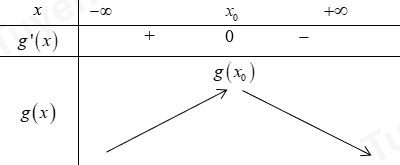
Bước 3: Biện luận nghiệm theo m.
Để phương trình đã cho có nghiệm thì \(m < g\left( {{x_0}} \right) \approx - 0,78\).
Kết hợp điều kiện đề bài ta có \(\left\{ \begin{array}{l} - 205 < m \le - 1\\m \in \mathbb{Z}\end{array} \right.\).
Vậy có 204 giá trị của nguyên của \(m\) thỏa mãn yêu cầu bài toán.
Cho hàm số \(y = f\left( x \right).\) Hàm số \(y = f'\left( x \right)\) có đồ thị như hình bên. Biết \(f\left( { - 1} \right) = 1,\)\(f\left( { - \dfrac{1}{e}} \right) = 2.\) Tìm tất cả các giá trị của m để bất phương trình \(f\left( x \right) < \ln \left( { - x} \right) + m\) nghiệm đúng với mọi \(x \in \left( { - 1; - \dfrac{1}{e}} \right).\)
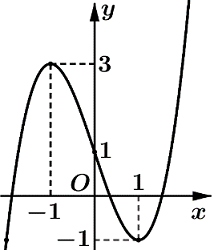
ĐKXĐ: \( - x > 0 \Leftrightarrow x < 0\).
Ta có: \(f\left( x \right) < \ln \left( { - x} \right) + m \Leftrightarrow m > f\left( x \right) - \ln \left( { - x} \right)\) (*)
Xét hàm số \(g\left( x \right) = f\left( x \right) - \ln \left( { - x} \right)\) trên khoảng \(\left( { - 1; - \dfrac{1}{e}} \right)\) có:
\(\,g'\left( x \right) = f'\left( x \right) - \dfrac{{ - 1}}{{ - x}} = f'\left( x \right) - \dfrac{1}{x}\)
Ta biểu diễn đồ thị hàm số \(y = \dfrac{1}{x}\) (nét màu đỏ) trên hình vẽ như sau:
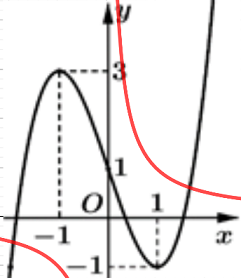
Quan sát đồ thị hàm số ta thấy
\(\,g'\left( x \right) = f'\left( x \right) - \dfrac{1}{x} > 0,\,\,\forall x \in \)\(\left( { - 1; - \dfrac{1}{e}} \right) \Rightarrow \) Hàm số \(y = g\left( x \right)\) đồng biến trên \(\left( { - 1; - \dfrac{1}{e}} \right)\).
Ta có: \(\left\{ \begin{array}{l}g\left( { - 1} \right) = f\left( { - 1} \right) - \ln \left( 1 \right) = 1\\g\left( { - \dfrac{1}{e}} \right) = f\left( { - \dfrac{1}{e}} \right) - \ln \dfrac{1}{e} = 2 + 1 = 3\end{array} \right.\) .
Để (*) nghiệm đúng với mọi \(x \in \left( { - 1; - \dfrac{1}{e}} \right)\) thì \( \Leftrightarrow m \ge \mathop {max}\limits_{\left[ { - 1; - \dfrac{1}{e}} \right]} g\left( x \right) \Leftrightarrow m \ge 3.\)
Xét các số thực không âm \(a,\,b\) thỏa mãn \(2a + b \le {\log _2}\left( {2a + b} \right) + 1.\) Giá trị nhỏ nhất của \({a^2} + {b^2}\) bằng bao nhiêu?
Đáp án:
Đáp án:
Bước 1: Đặt \(t = 2a + b\;\left( {t \ge 0} \right)\), đưa bất phương trình về dạng \(f\left( t \right) \ge 0\)
Đặt \(t = 2a + b\;\left( {t \ge 0} \right)\), ta có giả thiết đã cho tương đương với \(f\left( t \right) = {\log _2}t - t + 1 \ge 0\)
Ta có \(f'\left( t \right) = \dfrac{1}{{t\ln 2}} - 1 > 0 \Leftrightarrow t < \dfrac{1}{{\ln 2}}\) . Hàm số đồng biến trên \(\left( {0;\dfrac{1}{{\ln 2}}} \right)\)
Bước 2: Chứng minh \(t \ge 1\).
Ta chứng minh \(t \ge 1\) .
Thật vậy, giả sử \(t < 1\) thì \(f\left( t \right) < f\left( 1 \right) = 0\) (mâu thuẫn)
Vậy \(2a + b \ge 1\)
Áp dụng BĐT Cauchy – Schwarz ta có
\(\begin{array}{l}{\left( {2a + b} \right)^2} \le \left( {{2^2} + {1^2}} \right)\left( {{a^2} + {b^2}} \right) = 5\left( {{a^2} + {b^2}} \right)\\ \Rightarrow {a^2} + {b^2} \ge \dfrac{{{{\left( {2a + b} \right)}^2}}}{5} \ge \dfrac{1}{5}\end{array}\)
Dấu bằng xảy ra \(\left\{ \begin{array}{l}2a + b = 1\\\dfrac{a}{2} = \dfrac{b}{1}\end{array} \right. \Leftrightarrow \left\{ \begin{array}{l}a = \dfrac{2}{5}\\b = \dfrac{1}{5}\end{array} \right.\)
Có tất cả bao nhiêu giá trị nguyên của \(y\) sao cho tương ứng với mọi \(y\) luôn tồn tại không quá 63 số nguyên \(x\) thỏa mãn điều kiện \({\log _{2020}}\left( {x + {y^2}} \right) + {\log _{2021}}\left( {{y^2} + y + 64} \right) \ge {\log _4}\left( {x - y} \right).\)
Đáp án:
Đáp án:
Bước 1: Đặt \(f\left( x \right) = {\log _{2020}}\left( {x + {y^2}} \right) + {\log _{2021}}\left( {{y^2} + y + 64} \right) - {\log _4}\left( {x - y} \right)\) và tìm điều kiện xác định.
Đặt \(f\left( x \right) = {\log _{2020}}\left( {x + {y^2}} \right) + {\log _{2021}}\left( {{y^2} + y + 64} \right) - {\log _4}\left( {x - y} \right)\) (coi \(y\) là tham số).
Điều kiện xác định của \(f\left( x \right)\) là:
\(\left\{ {\begin{array}{*{20}{c}}{x + {y^2} > 0}\\{{y^2} + y + 64 > 0}\\{x - y > 0}\end{array}} \right.\)
Do \(x,\;y\) nguyên nên \(x > y \ge - {y^2}\). Cũng vì \(x,\;y\) nguyên nên ta chỉ xét \(f\left( x \right)\) trên nửa khoảng \(\left[ {y + 1; + \infty } \right)\).
Bước 2: Xét hàm số trên \(\left[ {y + 1; + \infty } \right)\)
Ta có:
\(f'\left( x \right) = \dfrac{1}{{\left( {x + {y^2}} \right)\ln 2020}} - \dfrac{1}{{\left( {x - y} \right)\ln 2021}} - \dfrac{1}{{\left( {x - y} \right)\ln 4}} < 0,\;\forall x \ge y + 1\)
Bước 3: Lập bảng biến thiên
Ta có bảng biến thiên của hàm số \(f\left( x \right):\)
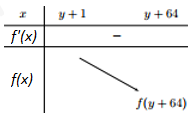
Bước 4: Tìm y nguyên \(f\left( {y + 64} \right) < 0\)
Yêu cầu bài toán trở thành:
\(f\left( {y + 64} \right) < 0\)
\( \Leftrightarrow {\log _{2020}}\left( {{y^2} + y + 64} \right) + {\log _{2021}}\left( {{y^2} + y + 64} \right) < {\log _4}64\)
\( \Leftrightarrow {\log _{2021}}\left( {{y^2} + y + 64} \right)\left( {{{\log }_{2020}}2021 + 1} \right) < 3\)
\( \Leftrightarrow {y^2} + y + 64 - {2021^{\dfrac{3}{{{{\log }_{2020}}2021 + 1}}}} < 0\)
\( \Leftrightarrow - 301,76 < y < 300,76\)
Mà \(y\) nguyên nên \(y \in \left\{ { - 301; - 300; \ldots ;299;300} \right\}\).
Vậy có 602 giá trị nguyên của \(y\) thỏa mãn yêu cầu.
Xét các số thực dương \(a\) và \(b\) thỏa mãn \({\log _3}\left( {1 + ab} \right) = \dfrac{1}{2} + {\log _3}\left( {b - a} \right)\). Giá trị nhỏ nhất của biểu thức \(P = \dfrac{{\left( {1 + {a^2}} \right)\left( {1 + {b^2}} \right)}}{{a\left( {a + b} \right)}}\) bằng:
Đáp án:
Đáp án:
Bước 1: Tìm điều kiện và tìm mối quan hệ giữa a và b từ đẳng thức bài cho.
ĐKXĐ: \(\left\{ \begin{array}{l}b - a > 0\\a,\,\,b > 0\end{array} \right.\).
Ta có:
\(\begin{array}{l}{\log _3}\left( {1 + ab} \right) = \dfrac{1}{2} + {\log _3}\left( {b - a} \right)\\ \Leftrightarrow {\log _3}\left( {1 + ab} \right) - {\log _3}\left( {b - a} \right) = \dfrac{1}{2}\\ \Leftrightarrow {\log _3}\dfrac{{1 + ab}}{{b - a}} = \dfrac{1}{2}\\ \Leftrightarrow \dfrac{{1 + ab}}{{b - a}} = \sqrt 3 \\ \Leftrightarrow 1 + ab = \sqrt 3 \left( {b - a} \right)\\ \Leftrightarrow \dfrac{1}{a} + b = \sqrt 3 \left( {\dfrac{b}{a} - 1} \right)\end{array}\)
Bước 2: Sử dụng BĐT Cô-si để đánh giá $\dfrac{a}{b}$
Áp dụng BĐT Cô-si ta có \(\dfrac{1}{a} + b \ge 2\sqrt {\dfrac{b}{a}} \) nên
\(\sqrt 3 \left( {\dfrac{b}{a} - 1} \right) \ge 2\sqrt {\dfrac{b}{a}} \Leftrightarrow \sqrt 3 \dfrac{b}{a} - 2\sqrt {\dfrac{b}{a}} - \sqrt 3 \ge 0\)
\( \Leftrightarrow \left[ \begin{array}{l}\sqrt {\dfrac{b}{a}} \ge \sqrt 3 \\\sqrt {\dfrac{b}{a}} \le - \dfrac{1}{{\sqrt 3 }}\,\,\left( {Loai} \right)\end{array} \right. \Leftrightarrow \sqrt {\dfrac{b}{a}} \ge \sqrt 3 \Leftrightarrow \dfrac{b}{a} \ge 3\)
Bước 3: Sử dụng BĐT Cô-si để đánh giá P.
Ta có: \(P = \dfrac{{\left( {1 + {a^2}} \right)\left( {1 + {b^2}} \right)}}{{a\left( {a + b} \right)}} = \dfrac{{1 + {a^2} + {b^2} + {a^2}{b^2}}}{{a\left( {a + b} \right)}}\).
Áp dụng BĐT Cô-si ta có \(1 + {a^2}{b^2} \ge 2\sqrt {{a^2}{b^2}} = 2ab\) nên \(1 + {a^2} + {b^2} + {a^2}{b^2} \ge {a^2} + {b^2} + 2ab = {\left( {a + b} \right)^2}\).
\( \Rightarrow P = \dfrac{{1 + {a^2} + {b^2} + {a^2}{b^2}}}{{a\left( {a + b} \right)}} \ge \dfrac{{{{\left( {a + b} \right)}^2}}}{{a\left( {a + b} \right)}} = \dfrac{{a + b}}{a} = 1 + \dfrac{b}{a} \ge 4\).
Vậy \({P_{\min }} = 4 \Leftrightarrow \left\{ \begin{array}{l}\dfrac{1}{a} = b\\\dfrac{b}{a} = 3\\a,\,\,b > 0,\,\,b - a > 0\end{array} \right. \Leftrightarrow \left\{ \begin{array}{l}\dfrac{1}{a} = 3a\\b = 3a\\a,\,\,b > 0,\,\,b - a > 0\end{array} \right. \Leftrightarrow \left\{ \begin{array}{l}a = \dfrac{1}{{\sqrt 3 }}\\b = \sqrt 3 \end{array} \right.\).
Xét các số thực \(x,y\) thỏa mãn \({2^{{x^2} + {y^2} + 1}} \le \left( {{x^2} + {y^2} - 2x + 2} \right){4^x}\). Giá trị lớn nhất của biểu thức \(P = \dfrac{{8x + 4}}{{2x - y + 1}}\) là $a+\sqrt{a}$
Tìm $a$
Đáp án:
Đáp án:
Bước 1: Chia cả 2 vế của bất phương trình cho $4^x$ và đặt \(t = {x^2} + {y^2} - 2x + 1\)
Nhận xét: \({x^2} + {y^2} - 2x + 2 = {\left( {x - 1} \right)^2} + {y^2} + 1 > 0\,\,\,\forall x,y\).
Bpt \( \Leftrightarrow {2^{{x^2} + {y^2} - 2x + 1}} \le {x^2} + {y^2} - 2x + 2\).
Đặt \(t = {x^2} + {y^2} - 2x + 1\), bất phương trình trở thành \({2^t} \le t + 1 \Leftrightarrow {2^t} - t - 1 \le 0\).
Bước 2: Xét hàm đặc trưng \(f\left( t \right) = {2^t} - t - 1\) và đánh giá $t$ từ đó đánh giá ${\left( {x - 1} \right)^2} + {y^2}$
Xét hàm số \(f\left( t \right) = {2^t} - t - 1\) có \(f'\left( t \right) = {2^t}\ln 2 - 1 = 0 \Leftrightarrow t = {\log _2}\left( {{{\log }_2}e} \right).\)
BBT:

Suy ra ta có \(0 \le t \le 1 \Rightarrow {\left( {x - 1} \right)^2} + {y^2} \le 1\).
Bước 3: Biến đổi P và tìm min, max
Ta có:
\(P = \dfrac{{8x + 4}}{{2x - y + 1}}\)\( \Leftrightarrow 2Px - Py + P = 8x + 4\)
\( \Leftrightarrow P - 4 = \left( {8 - 2P} \right)x + Py\)\( \Leftrightarrow 3P - 12 = \left( {8 - 2P} \right)\left( {x - 1} \right) + Py\)
\( \Leftrightarrow {\left( {3P - 12} \right)^2} \le \left[ {{{\left( {8 - 2P} \right)}^2} + {P^2}} \right]\left[ {{{\left( {x - 1} \right)}^2} + {y^2}} \right]\)
\( \Rightarrow {\left( {3P - 12} \right)^2} \le {\left( {8 - 2P} \right)^2} + {P^2}\)\( \Leftrightarrow 4{P^2} - 40P + 80 \le 0\)
\( \Leftrightarrow 5 - \sqrt 5 \le P \le 5 + \sqrt 5\)
Bước 4: Xét dấu “=” xảy ra
Dấu “=” xảy ra \( \Leftrightarrow \left\{ {\begin{array}{*{20}{c}}{\dfrac{{8 - 2P}}{P} = \dfrac{{x - 1}}{y} = - \dfrac{2}{{\sqrt 5 }}}\\{{{\left( {x - 1} \right)}^2} + {y^2} = 1}\end{array}} \right. \Leftrightarrow \left\{ {\begin{array}{*{20}{c}}{x - 1 = - \dfrac{2}{{\sqrt 5 }}y}\\{\dfrac{9}{5}{y^2} = 1}\end{array}} \right. \Leftrightarrow \left\{ {\begin{array}{*{20}{c}}{x = 1 \mp \dfrac{2}{3}}\\{y = \pm \dfrac{{\sqrt 5 }}{3}}\end{array}} \right.\)
\( \Rightarrow \max P = 5 + \sqrt 5 \) đạt được khi \(x = \dfrac{1}{3};y = \dfrac{{\sqrt 5 }}{3}\).
Vậy $a=5$

